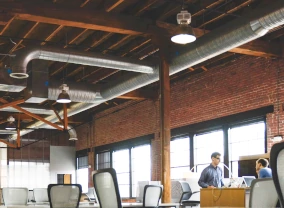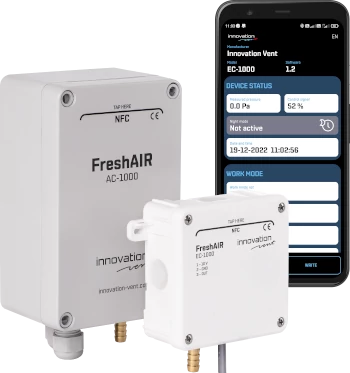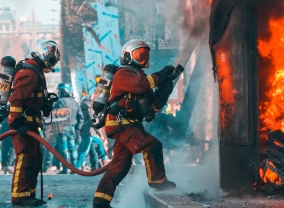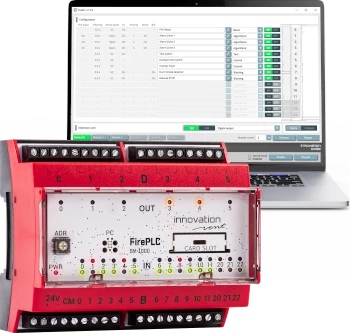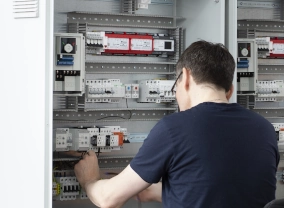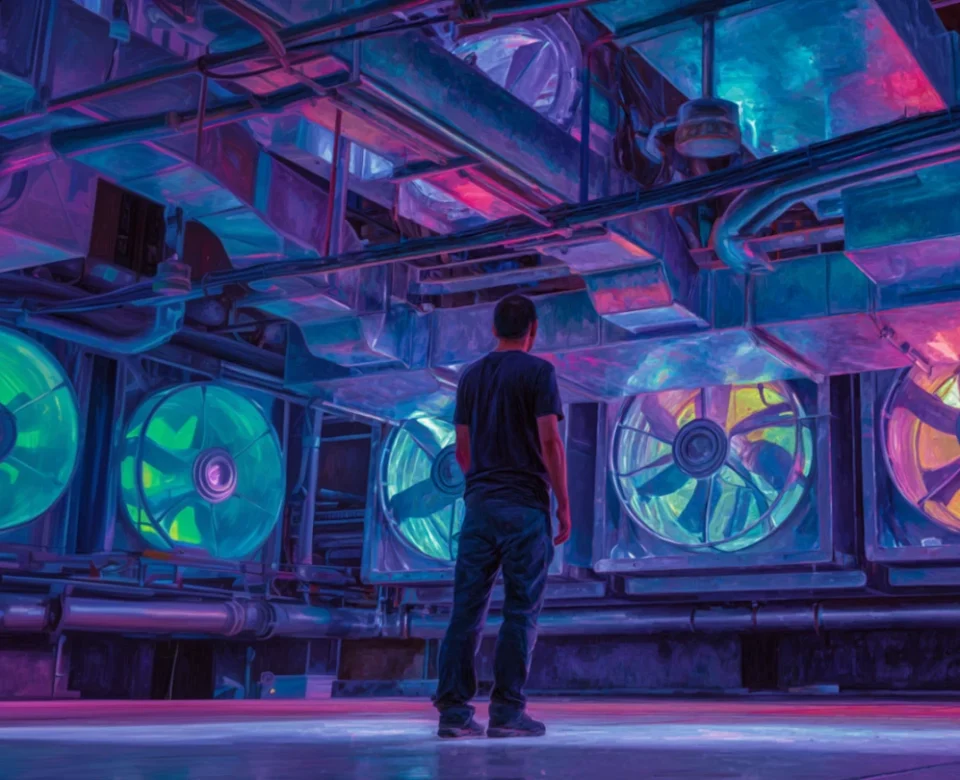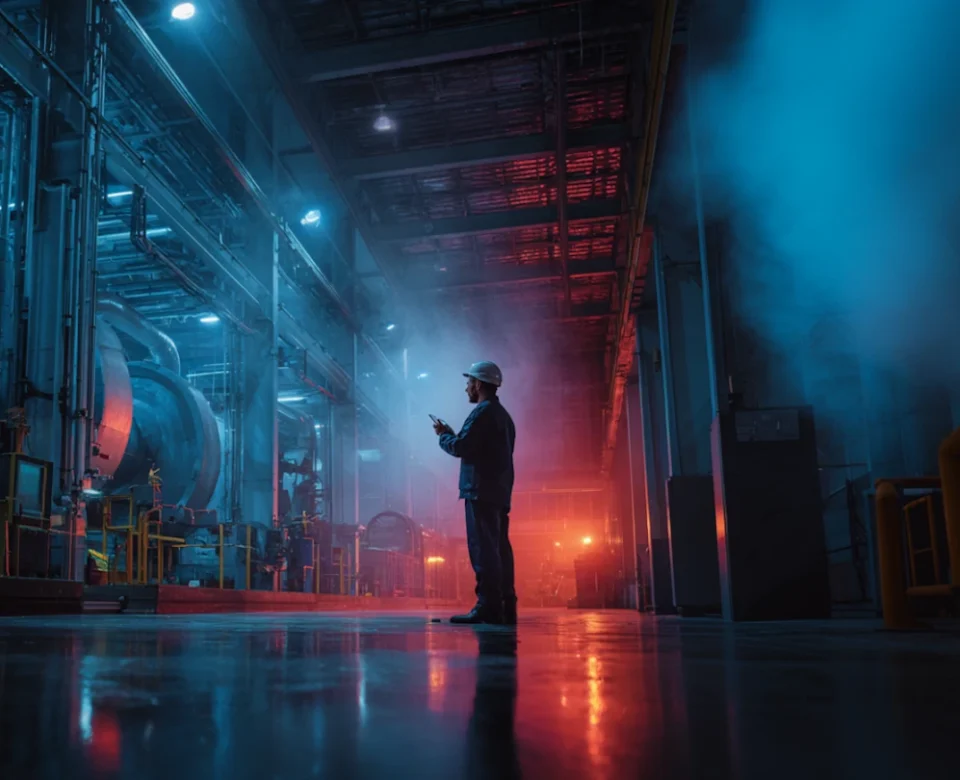
ISH 2023 and coming 2025 in Frankfurt: a hub of Innovation
2024-08-26
SHK+E ESSEN trade fair: event full of connections and innovation
2024-08-26When we think of fire safety, we often picture flames and heat. But there’s a silent killer that’s just as dangerous: smoke. In any fire, smoke can spread quickly, filling rooms and corridors with toxic fumes. This is where smoke extraction systems come into play. These vital systems work to remove smoke and hot gases, giving people more time to escape and helping firefighters do their job.
This article will explore the world of smoke extraction systems. We’ll look at how they work, why they’re important, and the key parts that make them effective. From basic ventilation to high-tech control panels, we’ll cover it all. Whether you’re a building owner, a safety manager, or just someone interested in fire protection, this guide will give you a clear picture of how smoke extraction systems keep us safe.
What you will learn:
- Why smoke is so dangerous in a fire and how smoke ventilation systems work
- Real examples of smoke extraction systems in action and safety standards
- New developments in smoke control technology
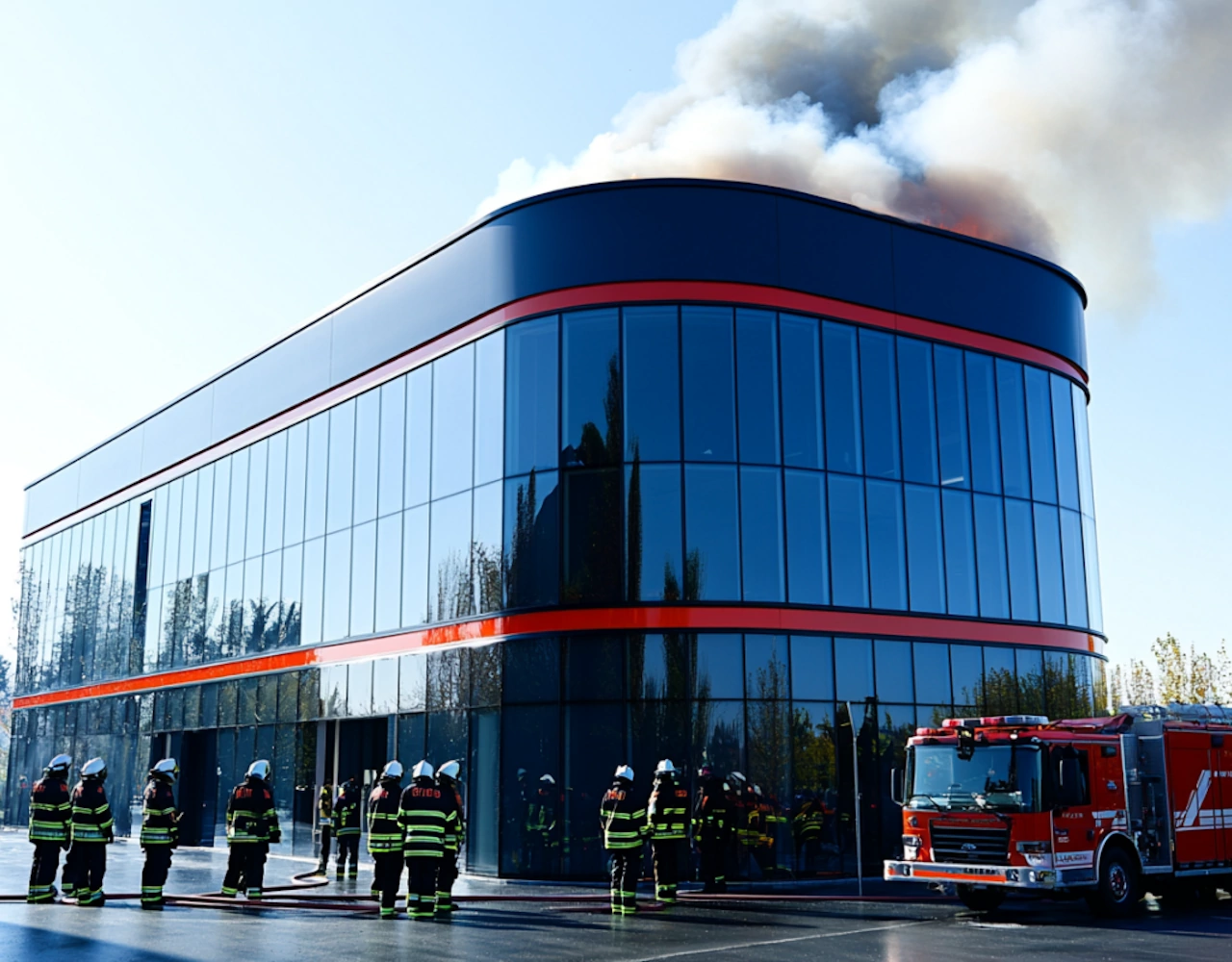
Now, let's dive into each section of our comprehensive guide to smoke extraction systems.
1. The “silent killer”: why smoke is your building's worst enemy
When a fire breaks out, most people think the flames are the biggest threat. But in many cases, it's the smoke that poses the greatest danger. Smoke from a fire is a complex mix of particles and gases. It's hot, toxic, and can spread much faster than flames.
Here's why smoke is so dangerous:
- It's fast: Smoke can fill a room in minutes, much quicker than fire spreads.
- It's blinding: Thick smoke makes it hard to see, trapping people inside buildings.
- It's toxic: Smoke contains harmful chemicals that can cause breathing problems or even death.
- It's hot: Smoke carries heat, which can cause burns and make fires grow faster.
In a fire, smoke rises because it's hot. It forms layers, with the hottest, most toxic smoke at the top. As it cools, it starts to sink. This is why staying low in a fire is safer – the air near the floor is clearer and cooler.
Smoke also makes it harder for firefighters to do their job. It hides the source of the fire and can mislead them about how big the fire is. This is why controlling smoke is so important for both escape and firefighting.
Understanding these dangers is the first step in seeing why smoke extraction systems are so crucial. They work to remove this deadly threat, giving people more time to get out safely and helping firefighters tackle the blaze.
2. Breathe easy: the basics of smoke ventilation systems
Smoke ventilation systems are designed to remove smoke and heat from a building during a fire. They create a safer environment for people to escape and for firefighters to work. Let's break down how these systems work:
The main goals of smoke ventilation are:
- To clear escape routes
- To make it easier for firefighters to find and put out the fire
- To protect the building by reducing heat and smoke damage
There are two main types of smoke ventilation:
Natural ventilation: This uses the buoyancy of hot smoke to rise and exit through vents in the roof or high on walls. It's simple but effective, especially in smaller buildings.
Mechanical ventilation: This uses fans to force smoke out of the building. It's more powerful and can be better for complex buildings or in windy conditions.
Both types work on the same basic principle: they create a path for smoke to leave the building. As smoke is removed, fresh air is drawn in from outside. This creates a clearer layer of air at lower levels, helping people to escape.
Key parts of a smoke ventilation system include:
- Smoke vents or exhaust points
- Air inlet vents
- Smoke barriers to create smoke-free zones
- Sensors to detect smoke and heat
- A control system to manage the whole process
In action, the system might work like this: Sensors detect smoke in a part of the building. The control system opens vents in that area and starts exhaust fans. At the same time, it opens air inlets lower down. This creates a flow that pulls smoke up and out, while keeping lower areas clearer.
Understanding these basics helps us see how smoke ventilation systems play a crucial role in fire safety. They don't put out fires, but they buy valuable time and can make the difference between life and death.
3. Command central: inside the smoke control panel
The smoke control panel is the brain of any smoke extraction system. It takes in information, makes decisions, and controls all the parts of the system. Let's look at what this crucial component does and how it works.
Key functions of a smoke control panel:
- Monitoring: It constantly checks sensors throughout the building for signs of fire or smoke.
- Activation: When smoke is detected, it starts the smoke extraction process.
- Coordination: It manages all parts of the system, like opening vents and starting fans.
- Communication: It sends alerts to building occupants and emergency services.
- Backup: It switches to backup power if the main power fails.
Parts of a typical smoke control panel:
- Main control unit: The central processor that runs the system
- Input connections: Where sensors and alarms connect
- Output connections: To control vents, fans, and other devices
- User interface: Screens and buttons for manual control and monitoring
- Power supply: Main and backup power sources
How it works:
When sensors detect smoke, they send a signal to the panel. The panel then follows its programmed sequence:
- It may first run a quick check to confirm there's really a fire.
- It activates alarms to alert people in the building.
- It opens specific vents and starts fans to create smoke-free escape routes.
- It might close fire doors to contain the smoke.
- It sends signals to elevators to return to the first floor.
- It alerts the fire department.
All this happens in seconds, much faster than any human could respond.
The panel also provides information to firefighters when they arrive. It can show them where the fire is, which systems are working, and allow manual control if needed.
Advanced panels can do even more:
- They can adjust the ventilation based on where the fire is and how it's spreading.
- They can integrate with other building systems like air conditioning.
- Some can even learn from data over time to improve their performance.
Understanding the smoke control panel helps us see how these systems can react so quickly and effectively to a fire. It's the key to coordinating all the parts of a smoke extraction system to save lives and protect property.
4. Design matters: planning an effective smoke extraction system
Creating an effective smoke extraction system isn't a one-size-fits-all process. It requires careful planning and design to ensure it will work well for a specific building. Here's what goes into planning a smoke extraction system:
- Building Assessment:
- Size and layout of the building
- How the building is used (office, factory, shopping center, etc.)
- Number of people typically in the building
- Existing fire safety measures
- Risk Analysis:
- Potential fire sources
- How smoke might spread
- Critical areas that need extra protection
- System Selection:
- Choose between natural or mechanical ventilation
- Decide on the size and number of vents needed
- Plan the locations of control panels and sensors
- Escape Route Planning:
- Identify main escape routes
- Ensure these routes can be kept smoke-free
- Integration with Other Systems:
- How the smoke system will work with fire alarms
- Coordination with sprinkler systems
- Links to building management systems
- Power Supply Planning:
- Ensure reliable main power supply
- Plan for backup power sources
- Control Strategy:
- Develop the sequence of operations for different scenarios
- Plan for both automatic and manual control options
- Compliance Check:
- Ensure the design meets all relevant building codes and standards
- Future-Proofing:
- Allow for possible building changes or expansions
- Consider upcoming changes in technology or regulations
- Testing and Commissioning Plan:
- Develop a plan for testing the system once installed
- Create a schedule for regular testing and maintenance
Key Considerations:
- Compartmentation: Dividing the building into smoke-tight sections can help control smoke spread.
- Stack effect: In tall buildings, the tendency of air to move upwards can affect smoke movement.
- Weather: Wind and outside temperature can impact natural ventilation systems.
- Pressurization: Creating areas of higher pressure can keep smoke out of critical spaces like stairwells.
A well-designed smoke extraction system takes all these factors into account. It's not just about having the right equipment – it's about having a system that's tailored to the specific needs and challenges of each building.
Good design can mean the difference between a system that works when needed and one that falls short. That's why it's crucial to involve experts in fire safety and smoke control when planning these systems. Their knowledge can help create a system that will effectively protect lives and property in the event of a fire.
5. The power of prevention: how smoke control saves lives
Smoke control systems are more than just a legal requirement or a box to tick. They play a crucial role in saving lives during a fire. Let's explore how these systems make such a big difference:
- Creating Safe Escape Routes:
- By removing smoke from corridors and stairways, people can see clearly to get out.
- Lower smoke levels mean less risk of breathing in harmful fumes.
- Clear routes also help firefighters move through the building safely.
- Buying Precious Time:
- Smoke is often the first killer in a fire, not the flames.
- By controlling smoke, these systems give people more time to evacuate.
- Even a few extra minutes can make a huge difference in saving lives.
- Reducing Panic:
- Clear air and visibility help people stay calmer during evacuation.
- This can prevent crush injuries and other accidents caused by panic.
- Protecting Those Who Can't Evacuate Quickly:
- In hospitals or care homes, not everyone can move fast.
- Smoke control gives more time for staff to help these vulnerable people.
- Aiding Firefighters:
- Clearer conditions help firefighters find the source of the fire faster.
- They can work more effectively and safely when there's less smoke.
- Preventing Smoke Damage:
- By removing smoke, these systems reduce damage to the building and contents.
- This can mean faster recovery after a fire, getting people back to normal life sooner.
- Early Warning:
- Smoke detectors linked to control systems can alert people to danger early.
- Fast response times increase the chances of everyone getting out safely.
- Protecting Critical Areas:
- Some parts of a building, like server rooms or emergency power supplies, are crucial.
- Smoke control can keep these areas functioning, supporting overall safety efforts.
Real-Life Example: In a high-rise apartment fire in London, the smoke control system kept stairwells clear for over an hour. This allowed all residents to evacuate safely, even from the top floors. Without this system, the outcome could have been much worse.
The impact of smoke control goes beyond just the immediate fire event:
- It gives people confidence in building safety.
- It can reduce insurance costs for building owners.
- It helps businesses recover faster after a fire, saving jobs and livelihoods.
While we hope never to need these systems, their presence provides peace of mind. Knowing that a building has effective smoke control can make everyone feel safer, from residents in an apartment block to workers in a high-rise office.
In the world of fire safety, prevention is always better than cure. Smoke control systems are a powerful tool in this prevention strategy. By managing one of the most dangerous aspects of a fire, they play a vital role in protecting both lives and property.
6. Going with the flow: natural vs. mechanical smoke ventilation
When it comes to smoke ventilation, there are two main approaches: natural and mechanical. Each has its strengths and is suited to different situations. Let's compare these two methods:
Natural Smoke Ventilation:
How it works:
- Uses the natural buoyancy of hot smoke to rise and exit through vents.
- Often involves roof vents or high-level wall openings.
- Fresh air enters through lower openings to replace the exiting smoke.
Advantages:
- Simple design with fewer moving parts
- Works without power, which is good in a blackout
- Often cheaper to install and maintain
- Can be very effective in buildings with large open spaces
Challenges:
- Depends on weather conditions; wind can affect performance
- May not work as well in very tall buildings due to stack effect
- Less control over the exact flow of smoke
Best for:
- Smaller buildings
- Structures with simple layouts
- Areas with predictable weather patterns
Mechanical Smoke Ventilation:
How it works:
- Uses powered fans to force smoke out of the building
- Can create pressure differences to control smoke movement
- Often includes a network of ducts to channel smoke
Advantages:
- More powerful and can overcome external factors like wind
- Provides more precise control over smoke movement
- Can be adjusted to changing conditions during a fire
- Works well in complex building layouts
Challenges:
- Relies on power to operate (though backup systems are used)
- More complex, with more parts that could potentially fail
- Usually more expensive to install and maintain
Best for:
- Larger, more complex buildings
- High-rise structures
- Buildings in areas with challenging weather conditions
Hybrid Systems: Some buildings use a mix of both natural and mechanical ventilation. This can provide the benefits of both systems:
- Natural vents for primary smoke removal
- Mechanical fans to boost performance when needed
Choosing the Right System: The decision between natural and mechanical ventilation depends on many factors:
- Building size and design
- Local climate and typical weather conditions
- Budget for installation and ongoing maintenance
- Specific risks in the building
- Local building codes and regulations
In practice, the choice often comes down to a careful analysis by fire safety experts. They consider all these factors to recommend the best solution for each specific building.
Both natural and mechanical systems can be effective when properly designed and maintained. The key is to choose the right system for your building's needs and to ensure it's regularly tested and serviced.
Remember, whether natural or mechanical, the goal is the same: to control smoke, protect escape routes, and give people the best chance of getting out safely in case of a fire.
7. Smart smoke management: the role of sensors and automation
In modern smoke extraction systems, sensors and automation play a crucial role. They allow the system to react quickly and intelligently to changing conditions. Let's explore how these technologies make smoke management smarter and more effective:
Types of Sensors:
- Smoke Detectors:
- Optical detectors: Spot smoke particles in the air
- Ionization detectors: Detect small particles produced by fast-flaming fires
- Heat Detectors:
- Respond to temperature changes
- Useful in areas where smoke detectors might give false alarms
- Carbon Monoxide (CO) Sensors:
- Detect this dangerous gas often produced in fires
- Airflow Sensors:
- Monitor the movement of air and smoke in ducts and vents
- Pressure Sensors:
- Help maintain the right air pressure in different zones
How Automation Works:
- Continuous Monitoring:
- Sensors constantly check for signs of fire or smoke
- Rapid Response:
- When smoke is detected, the system activates within seconds
- Adaptive Control:
- The system adjusts based on data from multiple sensors
- It can change fan speeds or open different vents as the situation evolves
- Zoned Operation:
- In large buildings, the system can focus on affected areas while maintaining safety elsewhere
- Integration with Other Systems:
- Works with fire alarms, sprinklers, and building management systems
Benefits of Smart Smoke Management:
- Faster Reaction Times:
- Automated systems respond much quicker than manual controls
- More Precise Control:
- Can fine-tune the response based on exact conditions
- Reduced False Alarms:
- Smart systems can cross-check data to confirm real fires
- Better Information for Firefighters:
- Provides real-time data about conditions in the building
- Energy Efficiency:
- Can run fans at optimal speeds, saving energy when full power isn't needed
- Easier Testing and Maintenance:
- Many systems can run self-tests and report issues automatically
Real-World Application: In a modern shopping mall, sensors detected smoke in a store. The system immediately:
- Activated extractors above the store
- Pressurized nearby escape routes
- Sent alerts to security and the fire department
- Adjusted air conditioning to prevent smoke spread. All this happened before anyone manually pulled a fire alarm.
Challenges and Considerations:
- Complexity:
- More advanced systems can be harder to maintain and troubleshoot
- Staff need proper training to use and understand these systems
- Cost:
- Smart systems often cost more upfront, though they may save money long-term
- Reliability:
- Systems need backup power and failsafe to ensure they work during emergencies
- Privacy Concerns:
- Some smart systems collect data, which raises questions about privacy and security
Future Trends:
- Artificial Intelligence (AI) to predict fire spread and optimize responses
- Integration with building-wide IoT (Internet of Things) systems
- Use of drones for aerial monitoring in large complexes
Smart smoke management systems represent a big step forward in fire safety. They offer faster, more effective responses to fires, potentially saving more lives and reducing property damage.
8. Building codes and beyond: meeting and exceeding safety standards
Building codes set the minimum requirements for safety, including smoke control. But many buildings go beyond these basics. Let's look at the standards and how some places exceed them:
Key Building Codes and Standards:
- International Building Code (IBC):
- Widely used in the US and elsewhere
- Sets requirements for smoke control in different types of buildings
- NFPA 92: Standard for Smoke Control Systems:
- Detailed guide for designing and testing smoke control systems
- EN 12101: Smoke and Heat Control Systems:
- European standard covering various aspects of smoke control
- Local and State Codes:
- Many areas have their own rules, often stricter than national standards
What These Codes Typically Require:
- Smoke extraction in stairwells and elevators
- Minimum vent sizes and airflow rates
- Regular testing and maintenance
- Backup power for smoke control systems
- Specific requirements for high-rise buildings
Going Beyond the Basics:
Some buildings exceed these standards for better safety:
- Higher Capacity Systems:
- Installing more powerful fans or larger vents than required
- Additional Sensors:
- Placing smoke detectors in more locations for faster detection
- Advanced Control Systems:
- Using more sophisticated automation than the minimum required
- Integrated Approach:
- Combining smoke control with other safety systems for better overall protection
- Regular Drills and Training:
- Going beyond required training to ensure staff know how to use the systems
- More Frequent Inspections:
- Checking systems more often than codes demand
Benefits of Exceeding Standards:
- Better protection for occupants
- Potential insurance benefits
- Enhanced reputation for safety
- Being prepared for future code changes
Challenges:
- Higher costs for installation and maintenance
- Need for more specialized knowledge
- Balancing advanced safety with other building needs (like energy efficiency)
Case Study: A new office tower in Singapore not only met local codes but added:
- Smoke extraction in every floor, not just common areas
- A building-wide smart system linking smoke control to all other systems
- Monthly testing instead of the required quarterly checks
While meeting codes is crucial, going beyond can provide extra safety and peace of mind. It's about finding the right balance for each building's needs and risks.
9. Case studies: real-life victories of smoke extraction systems
Nothing shows the value of smoke extraction systems better than real examples. Here are some cases where these systems made a big difference:
Case 1: High-Rise Hotel Fire. Situation: Fire broke out on the 26th floor of a 43-story hotel. Outcome:
- Smoke control system kept stairwells clear
- All 3,000 guests evacuated safely
- Firefighters reached the fire quickly due to clear conditions Key Factor: smoke extraction system prevented smoke entry
Case 2: Shopping Mall Incident. Situation: Small fire in a store created heavy smoke. Outcome:
- Smoke extracted before it spread to main areas
- Mall evacuated calmly with no injuries
- Limited damage, mall reopened next day Key Factor: Quick detection and automated response
Case 3: Underground Station Fire. Situation: Fire on a train in a busy subway station.Outcome:
- Smoke vented out, keeping platforms clear
- Over 1,000 people evacuated safely
- Fire contained to one area of the station Key Factor: Powerful mechanical extraction system
Case 4: Hospital Wing Fire. Situation: Fire in a patient room on the 3rd floor. Outcome:
- Smoke contained to the room of origin
- No evacuation needed for most patients
- Fire department praised the system's effectiveness Key Factor: Zoned smoke control kept other areas safe
Lessons Learned:
- Fast Response Matters: In many cases, the quick activation of systems saved lives.
- Regular Maintenance Pays Off: Well-maintained systems performed when needed.
- Staff Training is Crucial: In several cases, trained staff used systems effectively.
- Integration is Key: Systems that worked well with other safety features (like alarms) had the best outcomes.
- Proper Design is Essential: Systems tailored to the specific building performed best.
These real-life examples show that smoke extraction systems aren't just theory – they save lives and protect property when it matters most. They demonstrate why investing in good smoke control is so important for any building.
The future is clear: innovations in smoke control technology
Smoke control technology is always improving. New ideas are making these systems smarter, more effective, and easier to use. Let's look at some exciting developments:
- Artificial Intelligence (AI) and Machine Learning:
- Systems that learn from data to predict fire behavior
- AI-powered cameras that can spot fires faster than traditional sensors
- Smarter control systems that adjust in real-time to changing conditions
- Advanced Materials:
- New types of fire-resistant glass for smoke vents
- Lighter, stronger materials for fans and ducts
- Smart fabrics that can detect heat and smoke
- Green Technologies:
- Solar-powered backup systems for smoke control
- More energy-efficient fans and motors
- Systems that work with natural airflow to save power
- Internet of Things (IoT) Integration:
- Smoke control systems that talk to other building systems
- Remote monitoring and control via smartphones
- Better data collection for maintenance and improvement
- Virtual and Augmented Reality:
- VR training for firefighters and building staff
- AR displays for maintenance workers to see system layouts
- 3D modeling to test smoke flow in building designs
- Nano-technology Sensors:
- Tiny sensors that can detect smoke and gases more accurately
- Able to distinguish between different types of fires
- Drone Technology:
- Drones to inspect hard-to-reach vents and ducts
- Flying sensors to monitor smoke in large spaces
- Predictive Maintenance:
- Systems that can tell when parts are likely to fail
- Scheduling repairs before problems occur
- Modular and Adaptable Systems:
- Easy-to-update components for changing building needs
- Systems that can be quickly adjusted for different events or uses
- Enhanced Human-System Interfaces:
- More intuitive control panels for firefighters
- Voice-activated controls for faster response
Challenges and Considerations:
- Balancing new tech with reliability and simplicity
- Ensuring cybersecurity in more connected systems
- Keeping up with changing regulations
- Training people to use new technologies effectively
The Future Outlook: These innovations promise to make buildings safer than ever. We might see:
- Systems that start working before a fire is even visible
- Buildings that can 'heal' themselves during a fire, adapting to protect occupants
- Smoke control integrated with city-wide emergency systems
While some of these ideas are still in development, many are already being tested or used. The future of smoke control looks clearer and safer, with technology playing a bigger role in protecting lives and property.
11. Maintenance matters: keeping your smoke extraction system in top shape
A smoke extraction system is only as good as its maintenance. Regular upkeep is crucial to ensure these life-saving systems work when needed. Here's what you need to know:
Why Maintenance is Vital:
- Ensures the system will work in an emergency
- Extends the life of equipment
- Catches small issues before they become big problems
- Keeps the system compliant with regulations
- Can save money in the long run
Key Maintenance Tasks:
- Regular Inspections:
- Check all components visually
- Look for signs of wear or damage
- Ensure vents and ducts are clear of obstructions
- Testing:
- Activate the system to ensure all parts work
- Test sensors and alarms
- Check backup power sources
- Cleaning:
- Remove dust and debris from vents and fans
- Clean sensors to ensure accuracy
- Keep control panels free of dirt and grime
- Lubrication:
- Oil moving parts like fan bearings
- Ensure dampers move smoothly
- Calibration:
- Adjust sensors to maintain accuracy
- Ensure control systems are properly set
- Software Updates:
- Keep control system software current
- Update firmware on smart components
- Documentation:
- Keep detailed records of all maintenance
- Update system diagrams if changes are made
Maintenance Schedule:
- Daily: Visual checks by building staff
- Monthly: Basic tests of key components
- Quarterly: More thorough inspections and tests
- Annually: Comprehensive check of entire system
- Every 5 Years: Major overhaul or recertification
Who Should Do Maintenance:
- Some tasks can be done by trained building staff
- More complex work needs certified technicians
- Always follow manufacturer guidelines
Common Issues to Watch For:
- Blocked or damaged vents
- Worn fan belts
- Corroded electrical connections
- Dirty or faulty sensors
- Leaks in ductwork
The Role of Technology in Maintenance:
- Some new systems have self-diagnostic features
- Remote monitoring can alert to problems quickly
- Predictive maintenance software can schedule upkeep
Best Practices:
- Create a detailed maintenance plan
- Train staff on basic upkeep and what to look for
- Keep spare parts on hand for quick repairs
- Stay up to date with changing regulations
- Conduct regular fire drills to test the whole system
Remember, a well-maintained smoke extraction system can mean the difference between life and death in a fire. Regular upkeep isn't just about following rules – it's about ensuring safety when it matters most.
12. Cost vs. value: the long-term benefits of investing in smoke safety
When it comes to smoke extraction systems, the upfront cost can seem high. But looking at the long-term benefits shows why it's a smart investment. Let's break down the costs and values:
Initial Costs:
- Design and planning
- Equipment (vents, fans, sensors, control panels)
- Installation
- Integration with other building systems
- Initial testing and certification
Ongoing Costs:
- Regular maintenance
- Periodic testing
- Repairs and part replacements
- Training for staff
- Upgrades to meet changing codes
Long-Term Benefits:
- Life Safety:
- The primary benefit is protecting lives, which is priceless
- Reduced risk of injuries and deaths in a fire
- Property Protection:
- Less smoke damage means lower repair costs after a fire
- Potential for faster business recovery
- Insurance Benefits:
- Many insurers offer lower premiums for buildings with good smoke control
- Can lead to significant savings over time
- Legal Protection:
- Reduced risk of lawsuits related to fire safety
- Easier to show compliance with safety regulations
- Reputation:
- Buildings known for good safety can attract more tenants or customers
- Can increase property value
- Operational Benefits:
- Some systems can be used for daily ventilation, not just emergencies
- Can improve overall air quality in the building
- Energy Efficiency:
- Modern systems can work with HVAC for better energy use
- Potential for lower energy bills
- Flexibility:
- Good smoke control can allow more flexible building design
- Might permit larger open spaces or different layouts
- Future-Proofing:
- Investing in good systems now can mean less need for upgrades later
- Easier to adapt to changing building uses
Cost-Benefit Analysis: While exact numbers vary, studies often show that the benefits outweigh the costs:
- A study found that fire protection measures (including smoke control) typically pay for themselves in 5-10 years through reduced losses and insurance savings.
- In high-rise buildings, good smoke control can reduce property insurance premiums by 5-10% annually.
Factors Affecting Value:
- Building type and use
- Local fire risks and regulations
- Quality and type of system installed
- How well the system is maintained
Making the Decision: When considering smoke extraction systems:
- Look beyond just meeting minimum codes
- Consider the building's entire lifespan, not just short-term costs
- Factor in potential savings and benefits over time
- Consult with fire safety experts for the best value solution and in terms of applicable regulations
While the initial investment in smoke safety can be significant, the long-term benefits usually far outweigh the costs. It's not just about complying with rules – it's about creating a safer, more valuable, and more resilient building for the future.
Summary:
In this comprehensive guide to smoke extraction systems, we've explored every aspect of these crucial fire safety measures. We began by understanding why smoke is often the most dangerous element in a fire, capable of spreading rapidly and causing severe harm. This set the stage for appreciating the vital role of smoke extraction systems in protecting lives and property.
We delved into the basics of smoke ventilation, examining both natural and mechanical systems, and how they work to clear dangerous smoke from buildings. The importance of the smoke control panel as the brain of these systems was highlighted, showing how it coordinates all aspects of smoke management in an emergency.
The article emphasized the critical nature of proper system design, tailored to each building's specific needs and challenges. We explored how these systems save lives by creating safe escape routes, aiding firefighters, and buying precious time in dangerous situations.
Advanced technologies, including smart sensors and automation, were discussed, showcasing how modern systems can react quickly and intelligently to changing fire conditions. We also looked at the importance of meeting and often exceeding building codes and safety standards.
Case studies illustrated the effectiveness of well-designed and maintained smoke extraction systems in various emergency scenarios, from high-rise hotels to underground stations.
Looking to the future, we explored exciting innovations in smoke control technology, including the potential use of artificial intelligence and advanced materials to make these systems even more effective.
The critical importance of regular maintenance was stressed, outlining key tasks and schedules to keep systems in top working order. Finally, we examined the long-term value of investing in smoke safety, showing how the benefits often far outweigh the initial costs.
Throughout, we've seen that smoke extraction systems are not just regulatory requirements but vital components of building safety. They represent a crucial investment in protecting lives, preserving property, and ensuring buildings can withstand and recover from fire emergencies.
As building technology evolves and our understanding of fire dynamics improves, smoke extraction systems will continue to play a central role in comprehensive fire safety strategies. By staying informed about these systems and prioritizing their implementation and maintenance, building owners, managers, and occupants can all contribute to a safer built environment for everyone.
